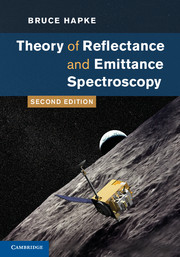Book contents
- Frontmatter
- Contents
- Acknowledgments
- 1 Introduction
- 2 Electromagnetic wave propagation
- 3 The absorption of light
- 4 Specular reflection
- 5 Single-particle scattering: perfect spheres
- 6 Single-particle scattering: irregular particles
- 7 Propagation in a nonuniform medium: the equation of radiative transfer
- 8 The bidirectional reflectance of a semi-infinite medium
- 9 The opposition effect
- 10 A miscellany of bidirectional reflectances and related quantities
- 11 Integrated reflectances and planetary photometry
- 12 Photometric effects of large-scale roughness
- 13 Polarization of light scattered by a particulate medium
- 14 Reflectance spectroscopy
- 15 Thermal emission and emittance spectroscopy
- 16 Simultaneous transport of energy by radiation and thermal conduction
- Appendix A A brief review of vector calculus
- Appendix B Functions of a complex variable
- Appendix C The wave equation in spherical coordinates
- Appendix D Fraunhofer diffraction by a circular hole
- Appendix E Table of symbols
- Bibliography
- Index
4 - Specular reflection
Published online by Cambridge University Press: 05 January 2012
- Frontmatter
- Contents
- Acknowledgments
- 1 Introduction
- 2 Electromagnetic wave propagation
- 3 The absorption of light
- 4 Specular reflection
- 5 Single-particle scattering: perfect spheres
- 6 Single-particle scattering: irregular particles
- 7 Propagation in a nonuniform medium: the equation of radiative transfer
- 8 The bidirectional reflectance of a semi-infinite medium
- 9 The opposition effect
- 10 A miscellany of bidirectional reflectances and related quantities
- 11 Integrated reflectances and planetary photometry
- 12 Photometric effects of large-scale roughness
- 13 Polarization of light scattered by a particulate medium
- 14 Reflectance spectroscopy
- 15 Thermal emission and emittance spectroscopy
- 16 Simultaneous transport of energy by radiation and thermal conduction
- Appendix A A brief review of vector calculus
- Appendix B Functions of a complex variable
- Appendix C The wave equation in spherical coordinates
- Appendix D Fraunhofer diffraction by a circular hole
- Appendix E Table of symbols
- Bibliography
- Index
Summary
Introduction
In this chapter the specular or mirror-like reflection that occurs when a plane electromagnetic wave encounters a plane surface separating two regions with different refractive indices is discussed quantitatively, along with the accompanying transmission, or refraction, through the interface. Specular reflection is important to the topic of this book for several reasons. First, it is an important tool for investigating properties of materials in the laboratory. Second, it occurs in remote-sensing applications when light is reflected from smooth parts of a planetary surface, such as the ocean. Third, it is one of the mechanisms by which light is scattered from a particle whose size is large compared with the wavelength, so that an understanding of this phenomenon is necessary to an understanding of diffuse reflectance from planetary regoliths.
Boundary conditions in electromagnetic theory
Whenever a volume contains a boundary separating regions of differing electric or magnetic constants, the components of De and Bm perpendicular to the surface and the components of Ee and Hm tangential to the surface must be continuous across the boundary. If the fields constitute an electromagnetic wave propagating through the surface from one medium to another, the amplitudes of the fields are different within the two regions. Therefore, the continuity conditions cannot be satisfied unless there is another wave propagating backward from the surface into the first medium, in addition to the wave propagating forward from the surface into the second medium.
- Type
- Chapter
- Information
- Theory of Reflectance and Emittance Spectroscopy , pp. 45 - 65Publisher: Cambridge University PressPrint publication year: 2012



